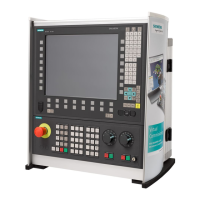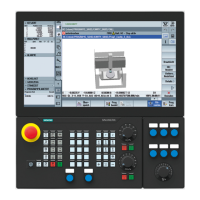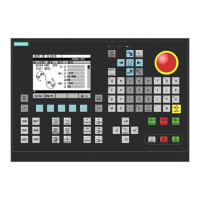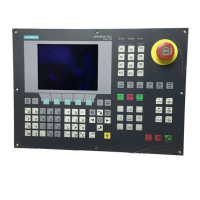Detailed Description
2.5 Toolholder with orientation capability
Tool Compensation (W1)
2-98 Function Manual, 08/2005 Edition, 6FC5397-0BP10-0BA0
Example
On the machine in the figure, the rotary axis of the table is pointing in the positive Y direction.
The table is rotated by +45 degrees. PAROT defines a frame, which similarly describes a
rotation of 45 degrees about the Y axis. The coordinate system is not rotated relative to the
actual environment (marked in the figure with "Position of the coordinate system after
TCARR"), but is rotated by -45 degrees relative to the defined coordinate system (position
after PAROT). If this coordinate system is defined with ROT Y-45, for example, and if the
toolholder is then selected with active TCOFR, an angle of +45 degrees will be determined for
the rotary axis of the toolholder.
Rotary table
With rotary tables (kinematic types P and M), activation with TCARR similarly does not lead to
an immediate rotation of the coordinate system (see figure), i.e., even though the zero point
of the coordinate system is offset relative to the machine, while remaining fixed relative to
the zero point of the workpiece, the orientation remains unchanged in space.
Activation of kinematic types P and M
With kinematics of type P and M the selection of a toolholder activates an additive frame
(table offset of the toolholder with orientation capability), which takes into account the zero
point offset as a result of the rotation of the table.
The zero offset can be written to a dedicated system frame $P_PARTFR.
For this, bit 2 must be enabled in machine data:
MD28082 $MC_MM_SYSTEM_FRAME_MASK.
The basic frame identified by machine data:
MD20184 $MC_TOCARR_BASE_FRAME_NUMBER
is then no longer required for the zero offset.
Activation of kinematic type M
With kinematics of type M (tool and table are each rotary around one axis), the activation of
a toolholder with TCARR simultaneously produces a corresponding change in the effective
tool length (if a tool is active) and the zero offset.
Rotations
Depending on the machining task, it is necessary to take into account not only a zero offset
(whether as frame or as tool length) when using a rotary toolholder or table, but also a
rotation. However, the activation of a toolholder with orientation capability never leads
directly to a rotation of the coordinate system.
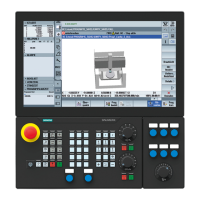
